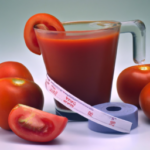Juice Tips and Tricks
How Many Carbs In Tomato Juice

I have always liked tomato juice and it’s a staple in my diet. However, following a low-carb lifestyle makes me wonder about the carb content in tomato juice. This is because carbs can add up quickly, possibly affecting my goal of living healthily.
In this article, we’ll explore the topic of carbohydrates in tomato juice in depth. We’ll cover the nutritional value of tomato juice, the factors that affect its carb content, and how different brands and preparation methods can impact its carb count. We’ll also provide some low-carb alternatives to tomato juice and offer tips on how to incorporate it into a low-carb diet.
So whether you’re a tomato juice enthusiast like me or simply looking to make more informed choices about your diet, read on to learn more about the carbs in tomato juice.
Key Takeaways
- Tomato juice has approximately 10 grams of carbs per cup, but store-bought varieties may contain added sugars that increase carb content and glycemic index.
- Tomato juice is a great source of vitamins and minerals, low in calories and fat, and can aid in regulating blood sugar levels, digestion, and heart health.
- Processing methods can affect the carb content and nutrient levels of tomato juice, with fresh tomato juice being the optimal choice.
- Individuals with tomato allergies should exercise caution, and those watching their sodium intake should opt for low-sodium options available in the market.
Understanding Carbohydrates
So, you’re probably wondering how many carbs are in that delicious tomato juice you’re sipping on. Carb counting is an important aspect of managing one’s diet, especially for individuals with diabetes or those trying to lose weight.
Carbohydrates are essential macronutrients that provide energy to the body, but not all carbs are created equal. The glycemic index (GI) is a scale that ranks carbohydrates based on how quickly they raise blood glucose levels. Foods with a high GI are rapidly digested and absorbed, causing a spike in blood sugar levels, while those with a low GI are digested more slowly, leading to a gradual increase in blood sugar levels.
Tomato juice is relatively low in carbohydrates, with approximately 10 grams of carbs per cup. It also has a low GI, meaning it won’t cause a rapid spike in blood sugar levels. However, it’s important to note that many store-bought tomato juices contain added sugars, which can significantly increase the carb content and GI. It’s always best to check the nutrition label and ingredient list to ensure you’re consuming a healthy and nutritious beverage.
So, let’s move on to the nutritional value of tomato juice.
The Nutritional Value of Tomato Juice
Tomato juice is a great source of vitamins and minerals, with a single serving providing over 20% of your daily recommended intake of potassium. Additionally, tomato juice is low in calories and fat, making it a great option for those looking to lose weight.
Many people enjoy tomato juice as a healthy and refreshing drink, but it can also be used in various recipes, such as soups, sauces, and cocktails.
For those looking to incorporate tomato juice into their diet for weight loss, it’s important to be mindful of added sugars. Some store-bought tomato juice brands may contain added sugars, which can increase the carb content. However, making your own tomato juice at home can ensure that it is free of added sugars and lower in carbs.
In the next section, we’ll explore the factors that affect the carb content in tomato juice.
Factors Affecting Carb Content
One important factor that affects the nutritional value of homemade tomato juice is the amount of added sugars. During harvest season, tomatoes are naturally sweet and require little to no added sugars for taste. However, processing methods can greatly affect the carb content of tomato juice.
For example, commercially processed tomato juice may contain added sugars or high fructose corn syrup to enhance the taste, which can significantly increase the carb content. It’s important to read labels and choose tomato juice brands that are low in added sugars or choose to make homemade tomato juice.
In the next section, we’ll explore the carb content of different brands of tomato juice to help you make informed choices.
Carbs in Different Brands of Tomato Juice
When it comes to choosing a brand of tomato juice, it’s crucial to be aware of the varying levels of carbohydrates. Brands comparison is essential to ensure that you make an informed decision about your carb intake.
Some brands of tomato juice have higher carb content than others, so it’s vital to check the label before making a purchase. Carb variations can depend on factors like added sugars, preservatives, and salt. For example, some brands may add sugar or high fructose corn syrup to enhance the taste, which can significantly increase the carb content.
Comparing the carb content between different brands of tomato juice can help you find a product that fits within your dietary needs and goals. With this knowledge in mind, let’s move on to comparing fresh and canned tomato juice.
Comparing Fresh and Canned Tomato Juice
By comparing fresh and canned options, I’ve noticed a significant difference in the taste and texture of tomato juice.
While canned tomato juice is convenient and readily available, it often contains added sugars and preservatives, which can alter the flavor and nutritional content of the juice.
On the other hand, fresh tomato juice has a richer and more complex flavor, and it contains higher levels of nutrients and antioxidants.
When it comes to sugar content, canned tomato juice often has added sugars to enhance the taste. Some brands even add high fructose corn syrup, which can significantly increase the sugar content.
Fresh tomato juice, on the other hand, has naturally occurring sugars and is a healthier option.
Overall, while canned tomato juice may be more convenient, fresh tomato juice is a better choice for those who want to enjoy the full flavor and nutritional benefits of this delicious drink.
Moving on to the next section about low-carb alternatives to tomato juice, there are some great options for those who are watching their carbohydrate intake.
Low-Carb Alternatives to Tomato Juice
If you’re looking for a healthier option that won’t derail your low-carb diet, there are plenty of tasty tomato juice substitutes to try. One option is vegetable juice, which typically contains fewer carbs and calories than tomato juice. You can also try making your own low-carb juice by blending green vegetables like spinach, kale, and cucumber with fresh lemon juice and a touch of ginger for added flavor.
Another low-carb drink option is coconut water. Not only is it low in carbs, but it’s also packed with electrolytes and other essential nutrients. If you’re looking for a hot beverage, try bone broth or herbal tea. Both are low in carbs and can help you feel full and satisfied.
Incorporating these low-carb drinks into your diet can help you stay on track and avoid the carb overload that comes with traditional tomato juice.
When it comes to incorporating tomato juice into a low-carb diet, there are a few things to keep in mind. While tomato juice does contain carbs, it can still be enjoyed in moderation as part of a balanced diet. Consider using it as a base for homemade marinades or salad dressings, or adding a small amount to soups and stews for added flavor.
By being mindful of your portions and incorporating tomato juice into your meals in creative ways, you can enjoy the taste and benefits of this nutritious beverage without derailing your low-carb diet.
Incorporating Tomato Juice into a Low-Carb Diet
To add some variety to your low-carb diet, try incorporating this nutritious beverage into your meals in creative ways. Tomato juice is a versatile ingredient that can be used in a variety of recipes, from soups and stews to marinades and dressings. Here are some ideas to get you started:
- Use tomato juice as a base for a flavorful and low-carb Bloody Mary.
- Add tomato juice to your favorite chili recipe for an extra burst of flavor.
- Use tomato juice as a marinade for chicken or fish to keep them moist and flavorful.
In addition to being a versatile ingredient, there are also many benefits to drinking tomato juice. It’s rich in vitamins and minerals such as vitamin C, potassium, and lycopene, which can help reduce the risk of heart disease and certain types of cancer. Drinking tomato juice can also help regulate blood sugar levels and aid in digestion. With so many benefits and uses, it’s easy to see why tomato juice should be a staple in any low-carb diet.
Moving on to the next topic, let’s explore the health benefits of tomato juice.
Health Benefits of Tomato Juice
I’m excited to dive into the health benefits of tomato juice.
Did you know that tomato juice can contribute to heart health by reducing inflammation and lowering cholesterol levels?
Additionally, the high fiber content in tomato juice can promote digestive health by aiding in regular bowel movements.
Heart Health
You’ll be happy to know that tomato juice is not only low in carbs, but it’s also great for your heart health. Drinking tomato juice can help lower blood pressure, thanks to the high levels of potassium and other nutrients.
Tomatoes are also a great source of antioxidants, which can help prevent damage to the heart and blood vessels. Incorporating tomato juice into your diet can lead to improved heart health and a lowered risk of heart disease.
However, tomato juice should not be relied on as the only solution for heart health. It’s important to maintain a balanced diet and exercise regularly to keep your heart healthy.
Moving on to the next topic, let’s discuss how tomato juice can benefit your digestive health.
Digestive Health
Feeling like your stomach is a ticking time bomb? Kickstart your digestive system with a glass of fiery lava that’ll erupt with cleansing power and soothe any gut discomfort.
Tomato juice is an excellent source of fiber, which helps to regulate bowel movements and promote healthy digestion. By consuming tomato juice regularly, you can improve your gut microbiome and increase your fiber intake.
A healthy gut microbiome is crucial for overall health, as it helps to boost your immune system and protect against harmful bacteria. In addition to its digestive benefits, tomato juice is also an excellent source of vitamins and minerals that your body needs to function properly.
It’s loaded with antioxidants, which can help to reduce inflammation and protect against chronic diseases. So, if you’re looking to improve your digestive health and overall wellbeing, consider adding tomato juice to your diet.
However, it’s important to note that excessive consumption of tomato juice can lead to certain risks and precautions, which we’ll explore in the next section.
Risks and Precautions
As I continue to explore the risks and precautions associated with consuming tomato juice, two key points come to mind:
-
It’s important to be mindful of the amount of sodium in tomato juice, as excessive consumption can lead to high blood pressure and other health issues.
-
Individuals with tomato allergies should take caution when consuming tomato juice or any tomato-based products to avoid potentially severe allergic reactions.
It’s crucial to pay attention to these risks and take necessary precautions to ensure a safe and healthy consumption of tomato juice.
Sodium Content
The sodium content in tomato juice can be a concern for those watching their intake. While tomato juice is generally considered a healthy beverage choice, it’s important to be aware of the sodium levels. High sodium intake has been linked to a number of health implications such as high blood pressure, heart disease, and stroke. Therefore, for individuals with pre-existing conditions such as hypertension, it is recommended to limit their sodium intake to about 1,500 mg per day.
Fortunately, there are low-sodium options available in the market for those who want to enjoy the health benefits of tomato juice without worrying about their sodium intake. It’s also important to note that even if a product is labeled as low-sodium, it is still important to check the nutrition label to ensure that it meets one’s dietary needs.
With that being said, let’s move on to the next subtopic about allergies.
Allergies
Now that we know about the sodium content of tomato juice, let’s talk about tomato juice allergies. As someone who has experienced allergies before, I understand how important it is to manage them properly. Tomato juice allergies can range from mild to severe reactions, such as hives, swelling, and difficulty breathing.
To help manage tomato juice allergies, it is important to understand the symptoms and potential triggers. Keeping a food diary and identifying which foods cause a reaction can be helpful in avoiding allergens in the future. Additionally, carrying an epinephrine auto-injector and wearing a medical alert bracelet can be life-saving in case of a severe allergic reaction.
Here is a table that shows some common allergy management strategies:
| Allergy Management Strategies |
|---|
| Avoidance of allergen |
| Medication (antihistamines, epinephrine) |
| Immunotherapy (allergy shots) |
| Emergency plan (carrying an epinephrine auto-injector, wearing a medical alert bracelet) |
By being aware of the potential risks and taking preventative measures, those with tomato juice allergies can still enjoy a healthy and diverse diet while minimizing the chances of an allergic reaction.
Frequently Asked Questions
Can tomato juice be consumed on a low-carb diet?
As a low-carb dieter, I can enjoy tomato juice in moderation. While it does contain some carbs, there are alternatives like vegetable juice. Plus, the benefits of tomato juice, like its high antioxidant content, make it a nutritious addition to any diet.
How much sugar is present in tomato juice?
I checked the sugar content of tomato juice and found it to be around 4 grams per 8-ounce serving. If you’re looking for lower sugar alternatives, try unsweetened vegetable juice or adding herbs for flavor.
Does cooking tomato juice affect its carb content?
Cooking tomato juice can affect its carb content, as heat can break down some of the carbohydrates. However, the overall nutritional value is not significantly impacted. It’s important to note that carb content can vary depending on the processing and additives used.
How does the carb content of homemade tomato juice compare to store-bought varieties?
I compared the nutritional benefits and taste of homemade tomato juice to store-bought varieties. Homemade juice had less added sugar and a fresher taste. Both contained similar carb amounts per serving.
Can consuming too much tomato juice lead to high blood sugar levels?
Drinking too much tomato juice can lead to high blood sugar levels, which can have negative effects on the body. However, moderate consumption can have benefits such as providing essential vitamins and minerals.
Conclusion
So, how many carbs are in tomato juice? After researching and analyzing various factors, it’s safe to say that the answer isn’t straightforward. The carb count in tomato juice can vary depending on factors such as the brand, whether the juice is freshly made, and if any additional ingredients like sugar have been added. On average, an 8-ounce serving of tomato juice typically contains around 8-10 grams of carbohydrates. However, it’s important to check the nutritional label for specific details to ensure accuracy.
The carb content of tomato juice can vary based on multiple factors such as the brand, the method of preparation, and the serving size. While some brands of tomato juice may be relatively high in carbs, others may offer a low-carb alternative.
Additionally, fresh tomato juice may have a different carb content than canned tomato juice. It’s important to carefully read nutrition labels and pay attention to serving sizes to ensure that you’re consuming an appropriate amount of carbs for your dietary needs.
Furthermore, it’s worth noting that tomato juice offers several health benefits, including being a rich source of vitamins and antioxidants. However, it’s always important to consult a healthcare professional before making any significant changes to your diet.
In conclusion, while the carb content of tomato juice may not be straightforward, with proper research and attention to detail, it’s possible to incorporate this nutritious beverage into a low-carb diet.
Susannah expertise lies in researching and compiling evidence-based content on juicing, nutrition, and overall health. She is committed to ensuring that The Juicery World offers accurate, up-to-date, and trustworthy information to empower readers to take control of their health. Susannah’s goal is to inspire individuals to embrace juicing as a way to nourish their bodies and live their best lives.
Juice Tips and Tricks
How to Make Aloe Vera Juice Taste Better

Tired of the strong flavor of aloe vera juice? No problem, we’ve got the answer for you.
In this article, we’ll share some tips and tricks to make your aloe vera juice taste better. We have tried and tested various methods to enhance the flavor without compromising the health benefits.
From choosing the right juice to adding natural sweeteners and infusing with fruits and herbs, we’ve got all the information you need to transform your aloe vera juice into a delightful and refreshing beverage.
Let’s dive in!
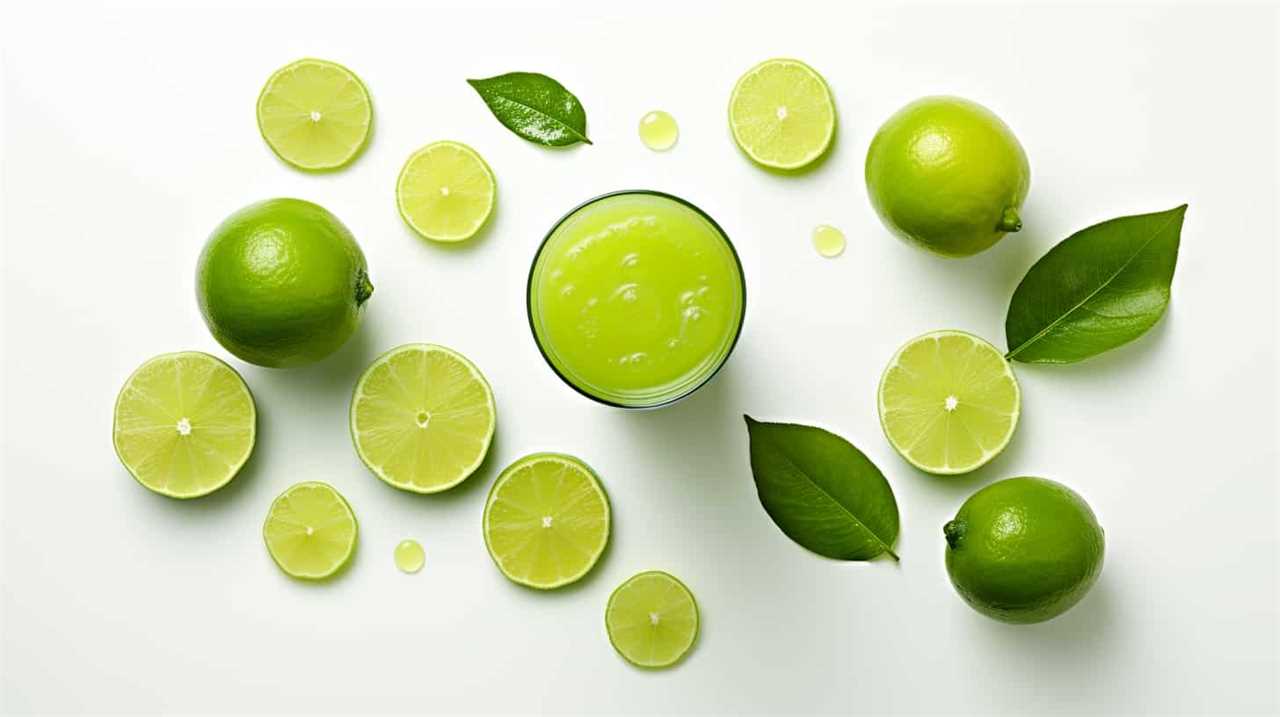
Key Takeaways
- Choose a reputable brand of aloe vera juice that prioritizes quality and uses organic, pure aloe vera.
- Avoid brands that contain added sugars or artificial ingredients.
- Use natural sweeteners like honey, agave syrup, or stevia to enhance the taste of aloe vera juice.
- Experiment with adding fruits, herbs, and other juices to create unique flavor combinations and enhance the health benefits of aloe vera juice.
Choosing the Right Aloe Vera Juice
We can enhance our experience with aloe vera juice by selecting the right brand and type for our preferences. When it comes to finding a reputable brand, it’s important to do some research and read reviews from other consumers. Look for brands that prioritize quality and use organic, pure aloe vera without any added sugars or artificial ingredients. Understanding the health benefits of aloe vera juice is also crucial in making the right choice. Aloe vera is known for its soothing properties, aiding digestion, promoting skin health, and boosting the immune system. By choosing a high-quality brand, we can ensure that we’re getting the maximum benefits from our aloe vera juice.
Now that we know how to choose the right brand, let’s move on to the next step of adding natural sweeteners.
Adding Natural Sweeteners
To enhance the flavor of our aloe vera juice, we can add natural sweeteners such as honey or agave syrup. Using alternative sweeteners not only adds sweetness but also brings unique flavors to the juice. Here are some options to consider:
- Stevia: A natural sweetener derived from the Stevia plant, it’s a zero-calorie alternative to sugar.
- Maple Syrup: This natural sweetener adds a rich and earthy flavor to the aloe vera juice.
- Dates: Pureed dates can be used to sweeten the juice while also providing essential nutrients like fiber.
In addition to using alternative sweeteners, we can enhance the flavor of aloe vera juice by adding spices and extracts. Cinnamon, ginger, or vanilla extract can add warmth and depth to the taste. By experimenting with different combinations of these natural sweeteners, spices, and extracts, we can create a flavor profile that suits our preferences.

Now, let’s move on to the next section and learn how to infuse aloe vera juice with fruits and herbs to further enhance its taste.
Infusing With Fruits and Herbs
As we explore ways to make our aloe vera juice taste better, one option to consider is infusing it with fruits and herbs. Creating unique aloe vera blends by adding fruits and herbs not only enhances the flavor but also adds a touch of freshness and complexity to the juice. For example, combining aloe vera juice with lemon, mint, or berries can create a refreshing drink that’s both delicious and packed with additional nutrients. It’s similar to the ease of making lemonade with bottled juice—quick, convenient, and customizable to suit your preferences. By experimenting with different fruit and herb combinations, you can elevate your aloe vera juice experience while still reaping its health benefits.
Fruits like strawberries, pineapple, or citrus can add a burst of sweetness, while herbs like mint, basil, or ginger can provide a subtle yet refreshing twist. Exploring the benefits of herbal infusions can also be beneficial for our health. For example, adding a few sprigs of lavender can promote relaxation and reduce stress. Additionally, infusing aloe vera juice with rosemary can aid digestion and boost the immune system.
Blending With Other Juices
Let’s try mixing aloe vera juice with different fruit juices to create delicious and refreshing blends. Blending aloe vera juice with other fruits not only enhances its taste but also adds nutritional benefits to your drink. Here are three fruit juices that you can mix with aloe vera juice:

- Orange juice: Combining aloe vera juice with orange juice not only adds a tangy flavor but also boosts your intake of vitamin C, which is essential for a strong immune system.
- Pineapple juice: Mixing aloe vera juice with pineapple juice creates a tropical blend that isn’t only refreshing but also helps in digestion. Pineapple contains bromelain, an enzyme that aids in breaking down proteins and promoting better digestion.
- Watermelon juice: Blending aloe vera juice with watermelon juice creates a hydrating and refreshing combination. Watermelon is rich in water content and contains electrolytes that can help replenish your body’s fluids.
Experimenting With Flavor Combinations
While we can try various flavor combinations with aloe vera juice, it’s important to find the right balance to enhance its taste. Experimenting with different flavors can’t only make the juice more enjoyable but also enhance its health benefits.
Aloe vera juice is known for its numerous health benefits, such as boosting digestion, promoting hydration, and supporting the immune system. By adding complementary flavors, we can create a refreshing summer drink that not only tastes great but also provides a nutritional boost.
Some popular flavor combinations include mixing aloe vera juice with citrus fruits like lemon or orange, adding a splash of coconut water for a tropical twist, or combining it with cucumber and mint for a refreshing and cooling effect.
Don’t be afraid to get creative and find the flavor combination that suits your taste buds best!

Frequently Asked Questions
Can I Use Store-Bought Aloe Vera Gel Instead of Fresh Aloe Vera for Making Juice?
Yes, you can use store-bought aloe vera gel instead of fresh aloe vera for making juice. However, it’s important to note that fresh aloe vera juice may have more health benefits due to its higher nutrient content.
How Long Can I Store Aloe Vera Juice in the Refrigerator?
Aloe vera juice can be stored in the refrigerator for up to a week. Refrigeration helps maintain the longevity and freshness of the juice, preserving its beneficial properties. It’s important to store the juice in an airtight container to prevent contamination and maintain its quality. Similarly, you might wonder *how long ginger juice lasts*; typically, fresh ginger juice can be refrigerated for about 1–2 weeks as well. Both aloe vera and ginger juices are best consumed within their shelf life to ensure maximum potency and health benefits. Additionally, freezing either juice can extend their shelf life, though some loss of nutrients and potency may occur during the process. When thinking about *how long fresh juice lasts*, it’s crucial to check for signs of spoilage, such as changes in smell, taste, or color, before consuming. To enjoy the best results, it’s always recommended to use fresh ingredients and properly store the juice to ensure you’re getting the most out of its health benefits.
Can Aloe Vera Juice Help With Digestive Issues?
Aloe vera juice can potentially help with digestive issues when taken in appropriate dosages. However, it is important to note that there may be potential side effects. It is always best to consult with a healthcare professional before starting any new supplement regimen.
Can I Use Artificial Sweeteners Instead of Natural Sweeteners in My Aloe Vera Juice?
Using artificial sweeteners in aloe vera juice may affect its taste and potential health benefits. However, natural sweeteners like honey or stevia can enhance the flavor without compromising its nutritional value.

Is It Safe to Drink Aloe Vera Juice Every Day?
Drinking aloe vera juice daily can have numerous benefits, such as improving digestion and boosting the immune system. However, consuming it regularly may also lead to potential side effects like diarrhea or stomach cramps.
Conclusion
In conclusion, making aloe vera juice taste better is easy and enjoyable.
By choosing the right aloe vera juice and adding natural sweeteners, infusing with fruits and herbs, blending with other juices, and experimenting with flavor combinations, you can create a delightful and refreshing drink.
So go ahead and unleash your creativity in the kitchen, and transform your aloe vera juice into a sensational elixir that will transport your taste buds to paradise.

Susannah expertise lies in researching and compiling evidence-based content on juicing, nutrition, and overall health. She is committed to ensuring that The Juicery World offers accurate, up-to-date, and trustworthy information to empower readers to take control of their health. Susannah’s goal is to inspire individuals to embrace juicing as a way to nourish their bodies and live their best lives.
Juice Tips and Tricks
How to Make a Glass of Lemonade With Bottled Lemon Juice

Are you craving a cool glass of lemonade to quench your thirst? Look no further! Try out our perfect recipe using bottled lemon juice that will surely please your taste buds.
In this article, we’ll guide you through the process of creating a tangy and sweet concoction that will leave you feeling refreshed and satisfied.
So grab your ingredients and let’s get started on this delightful journey of serving ourselves and others a glass of pure lemony goodness.
Key Takeaways
- Consider the storage of the bottled lemon juice (dark glass or plastic bottles, protect from light exposure, check expiration date)
- Choose a suitable pitcher and fresh lemons for enhanced flavor
- Store the lemonade concentrate in the refrigerator to maintain freshness
- Adjust the sweetness and tartness to taste with sugar or more lemon juice, and experiment with different sweeteners or additional flavors.
Choosing the Right Bottled Lemon Juice
What are the key factors we should consider when selecting the right bottled lemon juice for our lemonade?

One important factor is how the lemon juice is stored. Look for bottles that are made of dark glass or plastic, as they help protect the juice from light exposure, which can degrade its quality. It’s also important to check the expiration date to ensure freshness.
Another benefit of using bottled lemon juice is convenience. It saves time and effort compared to squeezing fresh lemons. Additionally, bottled lemon juice provides consistent flavor, as the acidity levels are standardized.
When selecting a brand, consider reading reviews and checking for certifications, such as organic or non-GMO.
Gathering the Necessary Ingredients and Tools
How can we gather all the necessary ingredients and tools to make a glass of lemonade with bottled lemon juice? First, we’ll need to collect bottled lemon juice, sugar, and cold water, as well as a pitcher and a spoon for mixing. If you prefer extra flavor, you can also gather ice and optional add-ins like mint or soda water. While preparing the lemonade, it’s easy to understand why some people wonder about other citrus drinks and may ask, “how many oranges per gallon” are needed when making orange juice instead. Once everything is assembled, combine the lemon juice, sugar, and water in the pitcher, stirring until the sugar dissolves. Feel free to adjust the sweetness or tartness to your liking, and don’t forget to add ice or any optional add-ins for an extra refreshing touch. This process might even make you curious about how much juice from oranges is needed when making fresh orange juice compared to using bottled citrus products. Once your lemonade is ready, pour it into a glass and enjoy the refreshing taste. This simple recipe can inspire you to try other homemade juices, such as learning **how to make pear juice** or experimenting with other fruit combinations. Whether you’re using fresh fruits or bottled options, creating your own beverages is a fun and rewarding way to personalize your drinks.
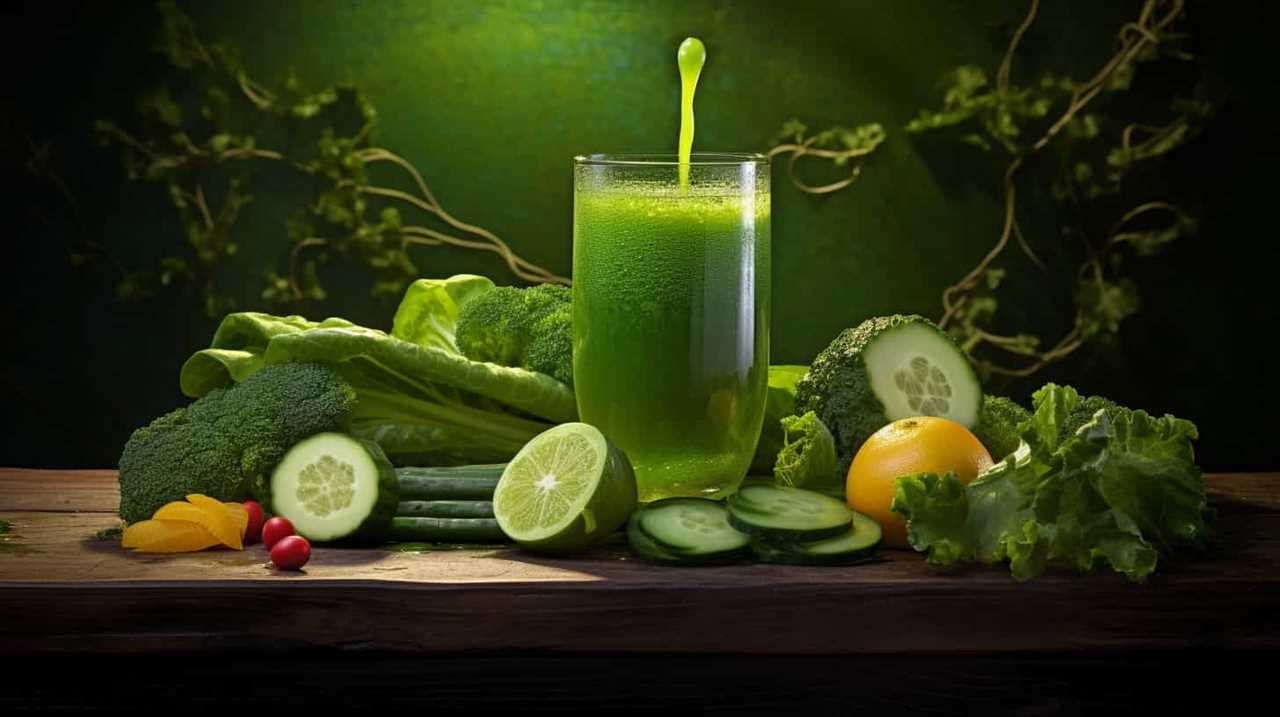
It’s important to start with the right pitcher. Look for a pitcher that’s made of glass or BPA-free plastic, as these materials won’t affect the taste of the lemonade. The pitcher should also have a lid or cover to keep the lemonade fresh and prevent spills.
Now, let’s talk about the lemons. While bottled lemon juice is convenient, using fresh lemons instead can elevate the flavor of your lemonade. Choose lemons that are firm and have a bright yellow color. Give them a gentle squeeze to ensure they’re juicy. To extract the juice, you’ll need a citrus juicer or a reamer. These tools make it easy to get every last drop of juice from the lemons.
Mixing the Lemonade Concentrate
To start mixing the lemonade concentrate, we’ll slowly pour the bottled lemon juice into the pitcher. It’s important to choose the right container for the lemonade concentrate. A pitcher with a lid or a tightly sealed container will help maintain the freshness and prevent any spills or leaks. Once the lemon juice is in the pitcher, we can move on to the next step of adding water and sweetener.
To ensure the lemonade concentrate stays fresh, it’s essential to store it properly. Keep the pitcher in the refrigerator to maintain its cool temperature and prevent any bacteria growth. If you have any leftover concentrate, transfer it to a smaller container with an airtight lid before refrigerating. This will help retain its flavor and prevent any contamination.

Now that we’ve mixed the lemonade concentrate, it’s time to adjust the sweetness and tartness to taste.
Adjusting the Sweetness and Tartness to Taste
We can adjust the sweetness and tartness of the lemonade to taste by adding more sugar or lemon juice, respectively. If you prefer a sweeter lemonade, simply add more sugar and stir until it dissolves completely. You can experiment with different sweeteners such as honey or agave syrup to find the perfect balance of sweetness.
On the other hand, if you want a tangier lemonade, add more lemon juice gradually, tasting as you go until it reaches your desired level of tartness.
Additionally, you can get creative with your lemonade by adding flavors like fresh mint leaves or a hint of lavender. These additions can elevate the flavor profile and create a more refreshing and unique experience.

Now that we’ve adjusted the sweetness and tartness of our lemonade, let’s move on to serving and enjoying your refreshing glass of lemonade.
Serving and Enjoying Your Refreshing Glass of Lemonade
Now let’s sit back, relax, and savor our refreshing glass of lemonade.
When it comes to serving and enjoying this delightful drink, there are a few techniques and garnishing options to consider.
Firstly, serving your lemonade chilled is essential for maximum enjoyment. Ensure that you have chilled glasses or add ice cubes to the glasses before pouring the lemonade.

To add a touch of elegance, you can garnish your lemonade with a slice of lemon on the rim of the glass. For an extra burst of flavor, you could also add a sprig of fresh mint or a few berries.
Remember to gently stir the lemonade before serving to evenly distribute the flavors.
Now, take a sip, feel the refreshing tang of lemon, and let the sweet and tart flavors dance on your taste buds.
Cheers!

Frequently Asked Questions
Can I Use Fresh Lemons Instead of Bottled Lemon Juice?
Fresh lemons offer numerous benefits over bottled lemon juice. The taste of fresh lemons is unparalleled, providing a vibrant and tangy flavor. Incorporating fresh lemons into your lemonade will elevate its taste and give it a refreshing and authentic twist.
Can I Substitute Sugar With a Different Sweetener?
Substituting sweeteners in lemonade can enhance the flavor and offer health benefits. We’re knowledgeable about alternative sweeteners and can provide precise, detailed instructions on using them in place of sugar.
How Long Does the Lemonade Concentrate Need to Chill in the Refrigerator?
The chilling time for the lemonade concentrate in the refrigerator is typically around 1-2 hours. Using bottled lemon juice offers the benefit of convenience and consistent flavor for a refreshing glass of lemonade.
Can I Add Other Fruits or Flavors to the Lemonade?
Sure, we can definitely add different fruits or flavors to our lemonade. It’s a great way to experiment with unique flavors and create refreshing, personalized drinks. The possibilities are endless!

How Long Does the Lemonade Stay Fresh in the Refrigerator?
Lemonade made with bottled lemon juice can stay fresh in the refrigerator for about 5-7 days. To maximize shelf life, store it in an airtight container and keep it chilled.
Conclusion
And so, with a few simple steps and the right ingredients, a glass of refreshing lemonade is born.
Like a symphony of flavors dancing on your taste buds, this tangy elixir quenches thirst and brings joy on a hot summer day.
Just a sip transports you to a world of citrusy delight, where the sweetness and tartness blend harmoniously.

So go ahead, indulge in the art of lemonade-making and savor every drop of this sun-kissed nectar.
Cheers to the perfect glass of lemonade!
Susannah expertise lies in researching and compiling evidence-based content on juicing, nutrition, and overall health. She is committed to ensuring that The Juicery World offers accurate, up-to-date, and trustworthy information to empower readers to take control of their health. Susannah’s goal is to inspire individuals to embrace juicing as a way to nourish their bodies and live their best lives.
Juice Tips and Tricks
How to Know if Orange Juice Is Bad

We’ve all been in that situation before – reaching for a glass of orange juice and hesitating, unsure if it’s still okay to drink. Fear not! This article will give you the knowledge you need to determine for sure if your orange juice is still fresh or if it’s gone bad.
With a blend of scientific precision and practical tips, we’ll explore color changes, strange smells, off taste, texture changes, and mold or growth that may indicate spoilage.
Let’s dive in and serve ourselves a refreshing glass of certainty!
Key Takeaways
- Color changes in orange juice can indicate a loss of freshness and shelf life extension, but it doesn’t necessarily mean the juice is bad.
- Unusual or off-putting odors in orange juice, such as sour or fermented scents, can be a sign of poor quality.
- An off taste in orange juice, such as sour, bitter, or fermented flavors, suggests that the juice is spoiled.
- Texture changes in orange juice, such as pulp separation or a thicker consistency, can occur as the juice ages, so it’s important to consume it before the expiration date.
Color Changes in Orange Juice
We should be aware that color changes can indicate whether orange juice is bad.

When it comes to orange juice, color is a crucial factor to consider. As oranges are exposed to air, an oxidation process occurs, which leads to changes in color. Fresh orange juice has a vibrant orange hue, indicating its freshness and high nutritional value.
However, as time passes, the juice may undergo a color change, turning dull or brownish. This change in color is a result of the oxidation process, which affects the flavor and quality of the juice. It’s important to note that while a change in color doesn’t necessarily mean the juice is bad, it does indicate that the juice is losing its freshness and shelf life extension.
Therefore, it’s advisable to consume orange juice when it’s at its freshest, as indicated by its vibrant orange color.
Strange Smells in Orange Juice
When it comes to evaluating orange juice, we should be cautious of any strange smells or odors. A fresh, pleasant smell is indicative of good quality orange juice. However, if you notice any unusual or off-putting odors, it may be a sign that the juice has gone bad. These smells can range from a sour or fermented scent to a rancid or moldy aroma.

It’s important to note that while some natural variations in scent can occur due to the specific variety of oranges used, any strong or unpleasant smells should raise concerns. If you have citrus fruit allergies, it’s especially important to pay attention to the smell of orange juice, as it could indicate the presence of spoilage or contamination.
Ensuring the quality of orange juice is essential as it’s a popular beverage known for its health benefits, including being rich in vitamin C and antioxidants.
Off Taste of Orange Juice
Our taste buds can detect even the slightest hint of an off taste in orange juice, which can indicate that it has gone bad. The taste of orange juice should be fresh, tangy, and slightly sweet. If it tastes sour, bitter, or fermented, it’s likely spoiled.
One common cause of an off taste in orange juice is the use of overripe oranges. When oranges become overripe, their flavor profile changes, resulting in a less pleasant taste. Another factor to consider is the expiration date. Orange juice that has passed its expiration date is more likely to develop an off taste. It’s important to check the expiration date before consuming orange juice to ensure its freshness and quality. Additionally, improper storage conditions, such as leaving the juice at room temperature for extended periods, can lead to the development of unpleasant flavors. Storing orange juice in the refrigerator helps maintain its freshness for longer. For those exploring different juice options, aloe vera juice flavor tips suggest pairing tart juices with milder flavors to balance the overall taste.
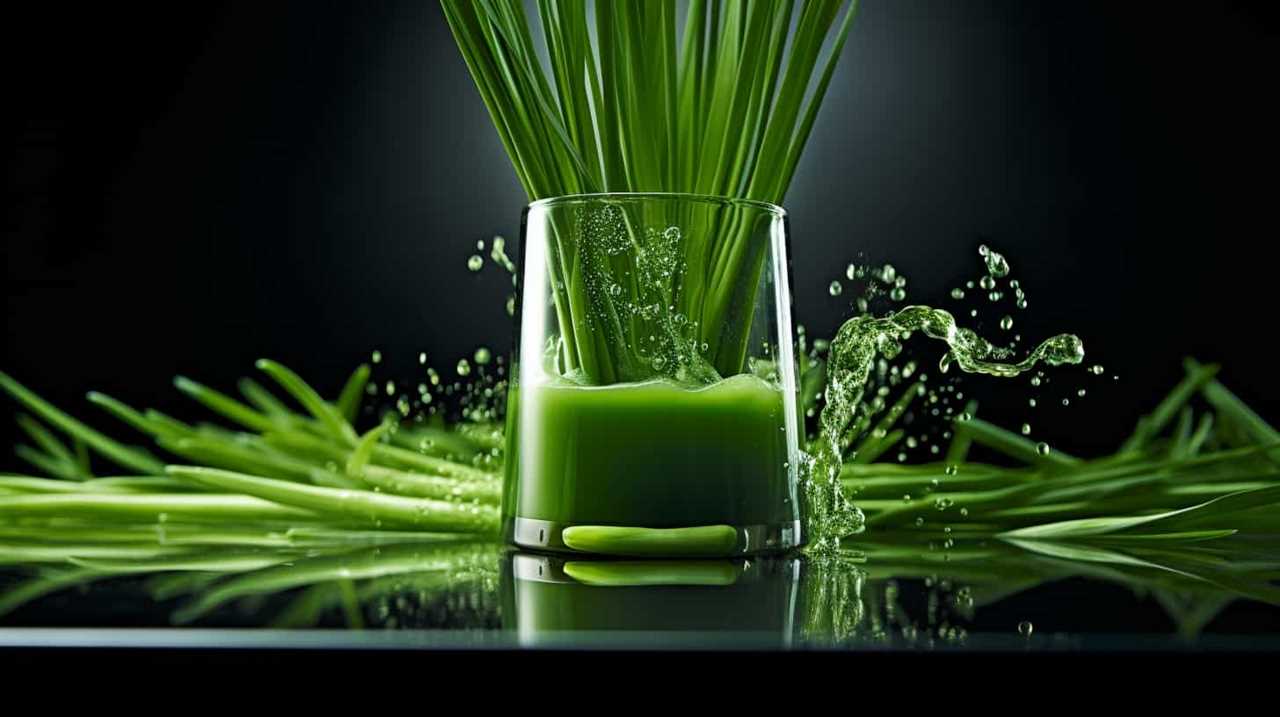
Now, let’s move on to discuss the texture changes in orange juice.
Texture Changes in Orange Juice
As we explore the texture changes in orange juice, it’s important to note that certain factors can cause it to become thicker or develop sediment. One common texture change in orange juice is pulp separation, where the pulp separates from the liquid and settles at the bottom. This can occur naturally over time, as the pulp particles become denser and sink.
Another factor that can affect the texture of orange juice is the expiration date. As orange juice ages, it may start to develop a thicker consistency and even form sediment. This is a result of the natural breakdown of the juice’s components. Therefore, it’s crucial to check the expiration date on orange juice and consume it before it reaches its expiration date to avoid any undesirable texture changes.
Mold or Growth in Orange Juice
We need to be aware of the possibility of mold or other growth occurring in orange juice. Mold can develop in orange juice if it isn’t stored properly or if it has passed its expiration date.

To prevent mold growth, it’s important to follow these steps:
- Store orange juice in the refrigerator at a temperature below 40°F (4°C).
- Check the expiration date on the bottle before consuming. Discard any orange juice that has expired.
- Keep the container tightly sealed to prevent air and moisture from entering, as these can promote mold growth.
Regularly inspecting orange juice for any signs of mold or unusual growth is essential. If you notice any discoloration, a strange odor, or visible mold, it’s best to discard the juice to avoid any potential health risks.
Frequently Asked Questions
Can Orange Juice Go Bad if It’s Stored in the Freezer for Too Long?
Frozen orange juice can potentially lose its nutrients and change its taste if stored in the freezer for too long. It is important to check for signs of spoilage before consuming it.
How Long Can Orange Juice Stay Fresh in the Refrigerator Once It’s Opened?
Once opened, orange juice can stay fresh in the refrigerator for about 7-10 days. To maintain its freshness, store it properly by keeping it tightly sealed and at a consistently cold temperature. If the orange juice develops an off odor, flavor, or appearance, it’s best to discard it to avoid any potential health risks. Factors like exposure to air and varying temperatures can influence how long orange juice lasts, so it’s crucial to handle it with care. Always check the expiration date as a general guide, but remember that proper storage can extend its freshness slightly. Additionally, avoid leaving the orange juice out at room temperature for extended periods, as this can significantly shorten how long orange juice lasts. Freezing the juice can be another option to extend its shelf life, but be aware that this may alter its texture and taste once thawed. By following these precautions, you can ensure your orange juice stays fresh and safe to consume.
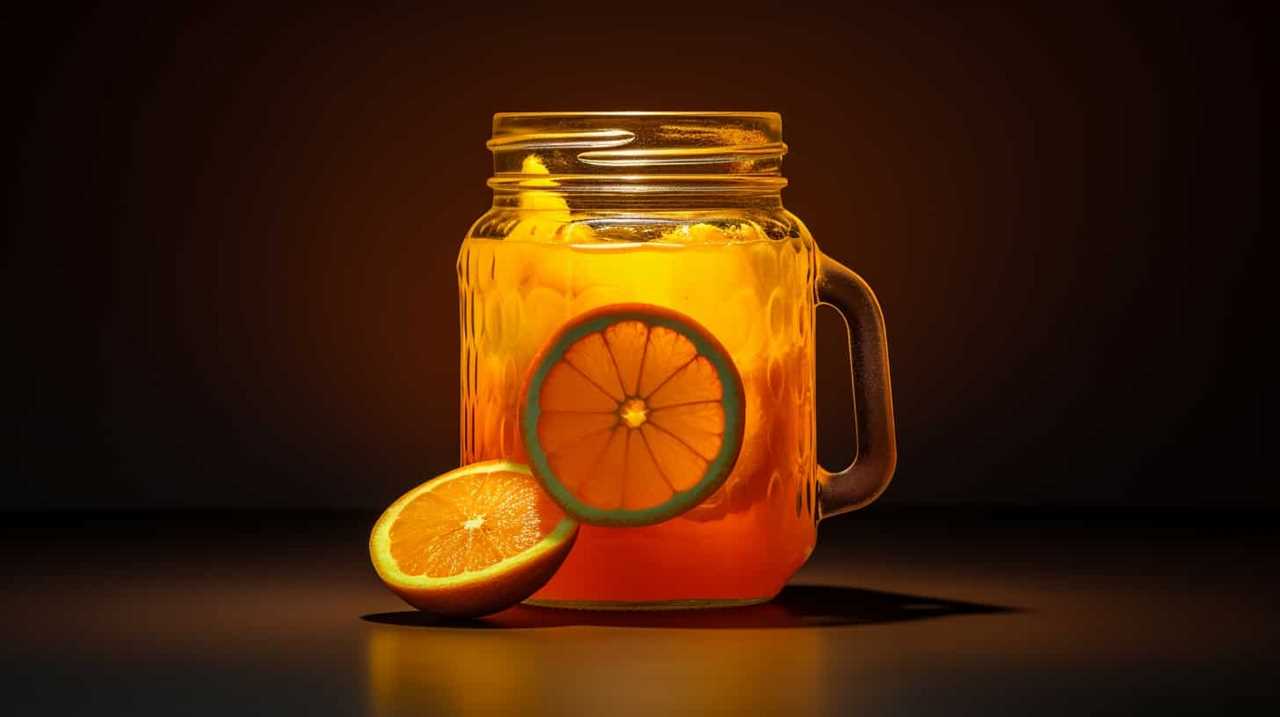
Is It Safe to Consume Orange Juice That Has Been Left Out at Room Temperature Overnight?
Left out orange juice may not be safe to drink as it can harbor harmful bacteria. Signs of spoiled orange juice include a sour smell, mold growth, and a change in color or taste.
Can Orange Juice Develop Harmful Bacteria if It’s Past Its Expiration Date but Still Looks and Smells Fine?
Orange juice can cause food poisoning if it develops harmful bacteria, even if it looks and smells fine. Signs of spoiled orange juice include a sour smell, mold growth, and a change in color or taste.
Does the Nutritional Value of Orange Juice Decrease as It Starts to Go Bad?
As orange juice goes bad, its nutritional value decreases. The longer it sits on the shelf, the more nutrients it loses. Signs of spoilage include a sour smell, off taste, and mold growth.
Conclusion
In conclusion, determining if orange juice is bad requires careful observation of color changes, strange smells, off taste, and texture changes. Just like a detective investigating a case, we must rely on our senses to detect any signs of spoilage.

If we detect mold or growth in the orange juice, it’s a clear indication that it’s no longer safe to consume. By remaining vigilant and attuned to these indicators, we can ensure that our orange juice is always fresh and enjoyable.
Susannah expertise lies in researching and compiling evidence-based content on juicing, nutrition, and overall health. She is committed to ensuring that The Juicery World offers accurate, up-to-date, and trustworthy information to empower readers to take control of their health. Susannah’s goal is to inspire individuals to embrace juicing as a way to nourish their bodies and live their best lives.
-

 Vetted2 months ago
Vetted2 months ago15 Best Juices for Diabetics: Refreshing Options That Won’t Spike Your Blood Sugar
-

 Vetted2 months ago
Vetted2 months ago15 Best Decaf Coffee Options for Flavor Lovers Who Need a Caffeine Break
-

 Vetted2 months ago
Vetted2 months ago15 Best Espresso Ground Coffees to Elevate Your Morning Brew
-

 Vetted2 months ago
Vetted2 months ago15 Best K-Cup Coffee Pods for a Perfect Brew Every Time
-

 Vetted2 months ago
Vetted2 months ago15 Best Beans for Espresso: A Guide to Perfecting Your Brew
-

 Vetted2 months ago
Vetted2 months ago15 Best Inexpensive Espresso Machines That Brew Quality Coffee on a Budget
-

 Vetted2 months ago
Vetted2 months ago15 Best Cold Brew Coffees to Keep You Refreshed All Summer Long
-

 Vetted2 months ago
Vetted2 months ago15 Best Kona Coffees to Savor the Rich Flavors of Hawaii



